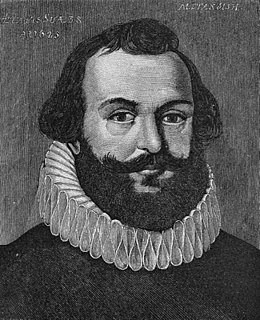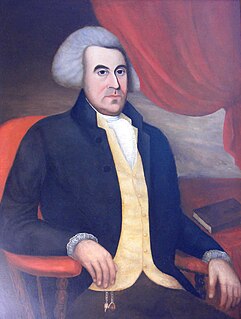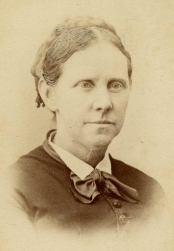
John Alden was a crew member on the historic 1620 voyage of the Mayflower which brought the English settlers commonly known as Pilgrims to Plymouth Colony in present-day Massachusetts, US. He was hired in Southampton, England, as the ship's cooper, responsible for maintaining the ship's barrels. Although he was a member of the ship's crew and not a settler, Alden decided to remain in Plymouth Colony when the Mayflower returned to England, opting to remain with the Pilgrims as a colonist. He was a signatory to the Mayflower Compact.

River Clyde is a river that flows into the Firth of Clyde in Scotland. It is the eighth-longest river in the United Kingdom, and the second-longest in Scotland. It runs through the major city of Glasgow. Historically, it was important to the British Empire because of its role in shipbuilding and trade. To the Romans, it was Clota, and in the early medieval Cumbric language, it was known as Clud or Clut. It was central to the Kingdom of Strathclyde.

Myles Standish was an English military officer. He was hired as military adviser for Plymouth Colony in present-day Massachusetts, United States by the Pilgrims. Standish accompanied the Pilgrims on the ship Mayflower and played a leading role in the administration and defense of Plymouth Colony from its foundation in 1620. On February 17, 1621, the Plymouth Colony militia elected him as its first commander and continued to re-elect him to that position for the remainder of his life. Standish served at various times as an agent of Plymouth Colony on a return trip to England, as assistant governor of the colony, and as its treasurer.

Duxbury is a historic seaside town in Plymouth County, Massachusetts, United States. A suburb located on the South Shore approximately 35 miles (56 km) to the southeast of Boston, the population was 15,059 at the 2010 census.

Newark Bay is a tidal bay at the confluence of the Passaic and Hackensack Rivers in northeastern New Jersey. It is home to the Port Newark-Elizabeth Marine Terminal, the largest container shipping facility in Port of New York and New Jersey, the third largest and one of the busiest in the United States. An estuary, it is periodically dredged to accommodate ocean-going ships.

Justin Winsor was a prominent American writer, librarian, and historian. His historical work had strong bibliographical and cartographical elements. He was an authority on the early history of North America. His self-confidence, energy and congeniality augmented his entrepreneurial skills and were well received by his peers, who elected him as the first president of the American Library Association.

George Partridge was an American teacher and politician. He represented Massachusetts as a delegate to the Continental Congress and as a Representative in the U.S. House.

Judith Winsor Smith was an American women's suffrage activist, social reformer, and abolitionist. She was involved in the suffrage movement until the Nineteenth Amendment was passed in 1920, when she voted for the first time at the age of 99. She was a founder and the first president of the Home Club of East Boston, one of the first women's clubs in Massachusetts.

The King Caesar House is a historic house located at 120 King Caesar Road, Duxbury, Massachusetts. It is operated as a non-profit museum by the Duxbury Rural and Historical Society.

The North River is a river, approximately 12 miles (19 km) long, in eastern Massachusetts, the United States. It is primarily a tidal river, formed by the confluence of the Indian Head River and Herring Brook. The North River forms the boundary between the towns of Norwell, Pembroke, Massachusetts, Hanover, Massachusetts and downstream, the boundary between Scituate and Marshfield. The river flows into Massachusetts Bay at New Inlet, where it also converges with the mouth of the South River. The North River area is also known as the "Irish Riviera" due to the large Irish American population that migrated during the 19th century.

The Old Shipbuilder's Historic District is a 287-acre (116 ha) historic district in Duxbury, Massachusetts. The district includes both sides of Washington Street extending from South Duxbury to Powder Point Avenue, including several side streets off of Washington and a small portion of St. George Street and Powder Point Avenue.

The Lagoda is a half-scale model of the whaling ship Lagoda, located at the New Bedford Whaling Museum. The original ship was built in 1826, converted to a whaling ship in 1841, and broken up in 1899. The model was commissioned in 1916 and is the world's largest whaling ship model.

The Myles Standish Burial Ground in Duxbury, Massachusetts is, according to the American Cemetery Association, the oldest maintained cemetery in the United States.

The Nathaniel Winsor Jr. House is a historic house located at 479 Washington Street Duxbury, Massachusetts. It currently serves as the headquarters of the Duxbury Rural and Historical Society.
Bridgeport Harbor is an inlet on the north side of Long Island Sound in Bridgeport, Connecticut. It was carved by the retreat of the glaciers during the last ice age approximately 13,000 years ago.

The Duxbury Rural and Historical Society (DRHS) is a non-profit organization in Duxbury, Massachusetts founded in 1883. Its mission is to "preserve and promote the heritage and rural character of the town of Duxbury and its environs." The DRHS owns several historic buildings, operates a library and archives, and maintains approximately 140 acres of conservation land in Duxbury.

Rufus Hathaway (1770–1822) was an American physician and folk art painter. He lived in southern Massachusetts, where he painted numerous portraits between 1790 and 1795. He later studied medicine and established himself as a doctor at Duxbury.

Ezra Weston II, also known as King Caesar, was a prominent shipbuilder and merchant who operated a large maritime industry based in Duxbury and Boston, Massachusetts. His father, Ezra Weston I, began small scale shipbuilding operations in Duxbury in 1763 and eventually came to be known as "King Caesar" for his success in business. Ezra Weston II, his only son, inherited the nickname when Ezra I died in 1822.
Gershom Bradford Weston, son of shipbuilding tycoon Ezra Weston II (1772-1842) and his wife Jerusha Bradford (1770-1833), who were both direct descendants of six Mayflower pilgrims. Gershom was a large man with reddish hair, weighing about 250 pounds.

The Cove Street Historic District encompasses a small 19th-century neighborhood area of Duxbury, Massachusetts. Located along Cove Street north of the town center, it was developed in the early 19th century to provide housing for workers in nearby shipyards. The architecture of the district includes a variety of single-family housing styles common to the region and time period. The district was added to the National Register of Historic Places in 2019.



















